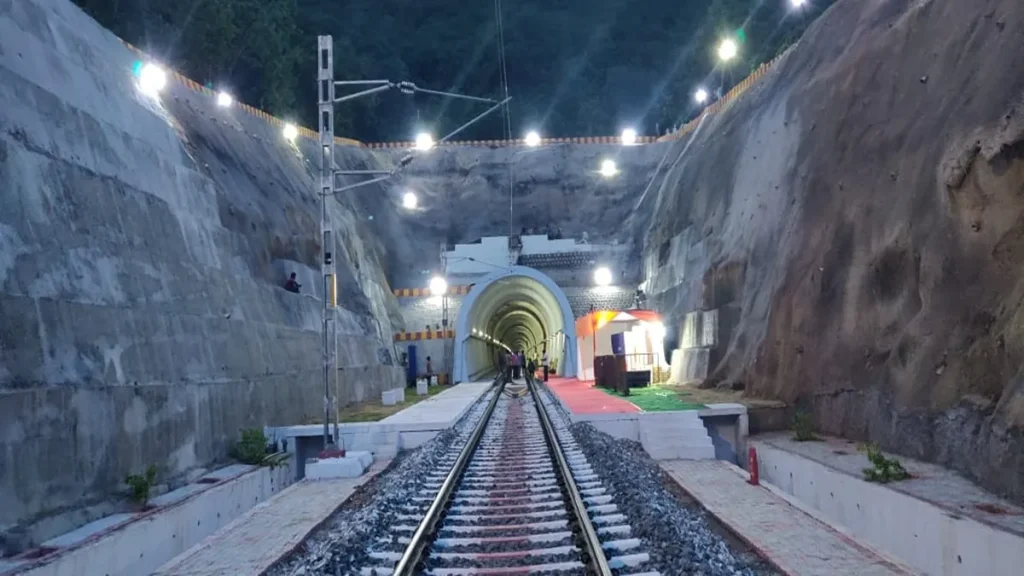Syllabus:
GS3: Infrastructure: Energy, Ports, Roads, Airports, Railways etc.
Context:
Janasu tunnel on the Rishikesh-Karnaprayag line marked a major milestone towards what is called to be the longest transport tunnel in India..
More on the News
The 14.58 km long tunnel no. 8 or the Janasu tunnel, falls on the Devprayag to Janasu stretch of the Rishikesh-Karnaprayag line.
Janasu tunnel overtakes the 12.75 km long rail tunnel, between Khari and Sumber Stations on the Katra-Banihal Section of the Kashmir line or the Udhampur-Srinagar-Baramulla Rail Link (USBRL).
- The longest road tunnel is the Atal tunnel (9.02 km long) on the Manali-Leh highway.
This is the first tunnel built by using a tunnel boring machine (TBM especially used in Hard rocks) in the Himalayan terrain.
- TBM especially used in Hard rocks and unlike the blasting method, it reduces the disturbance to the surroundings and the cost of lining the tunnel.
Along with TBM, the New Austrian Tunnelling Method (NATM) has also been used for controlled and small-scale excavation.
The TBM has tunnelled 10.4 km in tunnel no. 8, with 4.11 km excavated through NATM.
Rail Vikas Nigam Limited (RVNL), a public sector undertaking under the Ministry of Railways is the nodal organization of the project.
Rishikesh-Karnaprayag rail link project
- The Rishikesh-Karnaprayag rail link is a 125.20 km long, single-line broad-gauge railway project.
- Approximately 104 km or 83% of the route passes through tunnels due to the mountainous terrain.
- The project will connect five districts in Uttarakhand: Dehradun, Tehri Garhwal, Pauri Garhwal, Rudraprayag, and Chamoli.
Infrastructure Details
The alignment includes 12 new railway stations and 16 main tunnels.
It will also have 19 major bridges to navigate rivers and valleys.
- Five important bridges are part of the project:
- One on the Ganga
- One on the Chandrabhaga
- Three on the Alaknanda
- The longest bridge will be the Srinagar Bridge No. 9, which is 500 metres long.
- The highest bridge is the Gauchar Bridge, with a height of 46.9 metres.
12 escape tunnels covering 97.72 km will be built alongside the main tunnels for emergency evacuation.
7.05 km of cross passages will link the main and escape tunnels.
Geological Feature:
- Geologically, the tunnel predominantly traverses the Chandpur Formation of the Jaunsar Group.
- The principal rock unit is Chandpur Phyllite, which includes Quarzitic and Schistose Phyllite with Intercalations of Quartzite Rocks and presence of quartz veins.
- Presence of heterogeneous rock conditions ranging from poor to medium and hard rock poses significant challenges for excavation and support.
Significance of the Project

- The project will drastically reduce travel time.
- It will improve all-weather access to remote regions.
- It will boost tourism and economic development across Uttarakhand.
- It is also a critical step in realising the Char Dham rail connectivity initiative.
Mains Practice Question
Q: Discuss the environmental and strategic significance of the Rishikesh-Karnaprayag railway line project in the context of railway expansion in the Himalayan region.
PYQ: Why is Public Private Partnership (PPP) required in infrastructural projects? Examine the role of PPP model in the redevelopment of Railway Stations in India. (2022)

